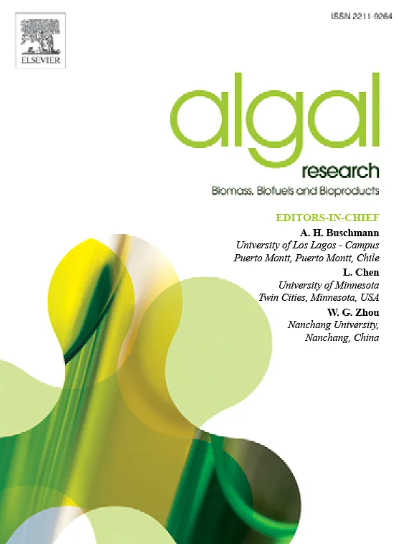Low-cost cocultivation of Vischeria stellata and Tribonema sp. biomass using molasses vinasse: A novel wastewater reuse model for functional aquatic feed production
IF 4.6
2区 生物学
Q1 BIOTECHNOLOGY & APPLIED MICROBIOLOGY
Algal Research-Biomass Biofuels and Bioproducts
Pub Date : 2025-04-18
DOI:10.1016/j.algal.2025.104051
引用次数: 0
Abstract
Microalgae can effectively sequester CO2, cultivating dense algal populations and producing high-value biomass in acidic environments poses significant challenges. This study explored the growth of unicellular Vischeria stellata GXU-A13 and filamentous Tribonema sp. GXU-A10 in acid molasses vinasse (MV). Results revealed that GXU-A13 exhibited strong acid tolerance, with maximum biomass reaching 2.71 g/L in MV wastewater (pH 5) and a COD removal rate of 49.4 % after 12 days. Notably, a mixed culture of the easily harvested GXU-A10 and acid-resistant GXU-A13 demonstrated enhanced wastewater treatment, with COD removal rates of 64.3 % and NH4-N removal rates of 54.9 %. Additionally, the GXU-10 and GXU-A13 co-culture also achieved efficient biomass recovery, and examined the effects of this biomass as feed on the growth and immune function of Oreochromis niloticus. Feeding O. niloticus with 2.5 % or 5 % GXU-A13 (V2 and V5 group) resulted in significant improvements in specific growth rate (SGR). Additionally, GXU-A13 significantly enhanced glutathione peroxidase (GSH-PX) activity and decreased malondialdehyde (MDA) levels, which contributed to a marked increase in intestinal microbial diversity. Furthermore, diets containing 2.5 % GXU-A13 (V2 group) and 2.5 % GXU-A10 (H2 group) exhibited stronger antioxidant capacity and immune response. The dual metabolic benefits of mixed algae (VH group) that contained 2.5 % GXU-A13 and 2.5 % GXU-A10 significantly improved intestinal and liver health, while enhancing O. niloticus tolerance to high-ammonia nitrogen wastewater (NH4+ concentration of 114 ± 3.2 mg/L). This study effectively integrates the unique characteristics of the two microalgae, enabling MV purification and recycling, advancing the development of a microalgae-based circular economy, and enhancing the quality and sustainability of aquatic feed.

利用糖蜜酒液低成本共培养星状Vischeria stellata和Tribonema sp.生物质:一种用于功能性水产饲料生产的废水回用新模式
微藻可以有效地固存CO2,在酸性环境中培养密集的藻群和生产高价值生物量是一个重大挑战。本研究探讨了单细胞星状粘菌GXU-A13和丝状Tribonema sp. GXU-A10在酸性糖蜜酒液中的生长情况。结果表明,GXU-A13具有较强的耐酸性,在pH为5的MV废水中处理12 d后,其最大生物量达到2.71 g/L, COD去除率为49.4%。值得注意的是,将易于收获的GXU-A10和耐酸的GXU-A13混合培养,其COD去除率为64.3%,NH4-N去除率为54.9%。此外,GXU-10和GXU-A13共培养也实现了高效的生物量回收,并研究了这些生物量作为饲料对尼罗褐虾生长和免疫功能的影响。添加2.5%或5% GXU-A13 (V2和V5组)可显著提高尼罗沼虾的特定生长率(SGR)。此外,GXU-A13显著提高了谷胱甘肽过氧化物酶(GSH-PX)活性,降低了丙二醛(MDA)水平,显著增加了肠道微生物多样性。此外,添加2.5% GXU-A13 (V2组)和2.5% GXU-A10 (H2组)的饲粮具有更强的抗氧化能力和免疫应答。含有2.5% GXU-A13和2.5% GXU-A10的混合藻(VH组)的双重代谢效益显著改善了肠道和肝脏健康,同时增强了O. niloticus对高氨氮废水(NH4+浓度为114±3.2 mg/L)的耐受性。本研究有效地整合了两种微藻的独特特性,实现了MV的净化和循环利用,推进了以微藻为基础的循环经济的发展,提高了水产饲料的质量和可持续性。
本文章由计算机程序翻译,如有差异,请以英文原文为准。
求助全文
约1分钟内获得全文
求助全文
来源期刊

Algal Research-Biomass Biofuels and Bioproducts
BIOTECHNOLOGY & APPLIED MICROBIOLOGY-
CiteScore
9.40
自引率
7.80%
发文量
332
期刊介绍:
Algal Research is an international phycology journal covering all areas of emerging technologies in algae biology, biomass production, cultivation, harvesting, extraction, bioproducts, biorefinery, engineering, and econometrics. Algae is defined to include cyanobacteria, microalgae, and protists and symbionts of interest in biotechnology. The journal publishes original research and reviews for the following scope: algal biology, including but not exclusive to: phylogeny, biodiversity, molecular traits, metabolic regulation, and genetic engineering, algal cultivation, e.g. phototrophic systems, heterotrophic systems, and mixotrophic systems, algal harvesting and extraction systems, biotechnology to convert algal biomass and components into biofuels and bioproducts, e.g., nutraceuticals, pharmaceuticals, animal feed, plastics, etc. algal products and their economic assessment
 求助内容:
求助内容: 应助结果提醒方式:
应助结果提醒方式:


